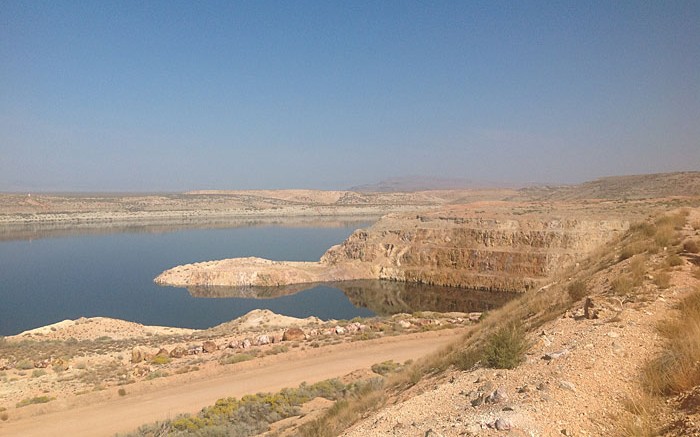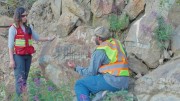WINNEMUCCA, NEV. — For Nevada-based explorer Paramount Gold and Silver (PZG-T, PZG-X), there’s a lot to be said for making something old new again. In mid-2010 the company picked up the past-producing Sleeper gold-silver mine, which operated from 1986 to 1996, and produced roughly 1.65 million oz. gold and 2.3 million oz. silver during its mine life. At the time Sleeper was one of the lowest-cost gold mines in the world, and Paramount believes the old mine has a robust future.
Sipping coffee inside Paramount’s headquarters in the mining town of Winnemucca, vice-president of exploration Glen van Treek, who joined Paramount after a 10-year stint with Teck Resources, stands to present his geological model and outline Paramount’s exploration strategy going forward.
Sleeper lies within the western reaches of the northern Nevada rift, specifically along the Slumbering Hills, which consists of Mesozoic meta-sedimentary rocks of the Auld Lang Syne group and Cretaceous granitic intrusions. Mineralization at Sleeper falls into four main categories, including: early quartz-pyrite-marcasite stockwork, intermediate silica-pyrite-marcasite cemented breccias tied to zones of structural weakness, late-stage zones of high-grade banded quartz veins and post-alluvial, gold-silver deposits in Pliocene gravels.
During previous operations all four types of mineralization were mined, with high-grade material passing through a milling circuit, while lower-grade ore was processed via heap leaching. What made Sleeper so strong initially were bonanza-grade veins composed of layers of quartz-adularia-electrum, with minor carbonate, barite and late stibnite. The veins locally averaged over 500 grams gold per tonne within the Sleeper pit, but with those mined out, Paramount is increasing tonnage and exploring its options regarding sulphide material and lower-grade oxides.
A tour group exits Paramount’s offices and hops into a pair of white pick-up trucks for a quick ride along Interstate 80 to the Sleeper site, which lies just off the paved roadway with high-tension electrical power lines tapping 120 kilovolts into the project. Chain-link fences encircle worn, administrative offices at Paramount’s Facilities zone, which serves as the company’s base of operations.
Standing on the edge of the past-producing pit, you can get a read on the layout of Paramount’s proposed operations. The pit will need to be dewatered, as it is currently a serene lake complete with various birds and a small boat the company uses to take samples from the pit walls. Van Treek points out the locations where Paramount has completed 16,000 metres of drilling since Sleeper was acquired, which led to an updated resource and preliminary economic assessment (PEA) in mid-2012.
“We have demonstrated that it can once again be a successful gold and silver producer,” says president and CEO Christopher Crupi. “The PEA estimates relatively low start-up capital and unit operating costs, which make it a valuable opportunity, especially in the present gold-price environment and considering our proximity to existing infrastructure.”
Sleeper would carry a US$346-million start-up cost and operate at 81,000 tonnes per day over a 17-year mine life. The development would carry a US$1.2-billion pre-tax net present value and a 26.8% internal rate of return at a 5% discount rate and US$1,384 per oz. gold price. Sleeper would process 30 million tonnes per year and produce 172,000 oz. gold and 263,000 oz. silver annually, at cash costs of US$767 per oz.
Paramount’s drilling continues to return results that could lead to another pit expansion and less waste in the company’s mine plan that could improve operating economics.
In early January Paramount released results from its South Sleeper zone, which lies outside the current in-pit resource. South Sleeper is hosted in intensely altered acid and intermediate volcanic rocks with mineralization in stockwork veins, breccias and disseminated in surrounding rock.
Highlights from assays released on Jan. 13 from South Sleeper include: 26 metres grading 0.31 gram gold and 2.8 grams silver from 143 metres depth in hole 12-024, and 48 metres averaging 0.22 gram gold and 2.1 grams silver from 146 metres depth in hole 12-025.
“We’re working to optimize the economics,” van Treek explains as a drill turns on a pad at South Sleeper. “It is a surprisingly robust project given the grades we are seeing, and that’s primarily due to high volumes and low capital costs. Most of the work is committed to growing that resource and trying to improve the grade in a bid to make the numbers even more attractive.”
Promising numbers emerged in early March, when Paramount released results from its Wood zone located on the southwestern tip of the old pit. Hole 12-027 cut some of the company’s highest grades to date, including 162 metres grading 1.04 grams gold and 13.1 grams silver from 91 metres depth, with a higher-grade interval of 83 metres averaging 1.43 grams gold and 22.2 grams silver.
During a drive across the site, Crupi says the company is proceeding with more drilling near the designed pit to find higher-grade material that can net higher estimated cash flows and extend the mine’s life. “We are also planning further metallurgical test work, which could enable us to include the Westwood higher-grade deposit as in-pit resources in the next engineering study,” he says.
Another area where Paramount may have room to improve involves its processing circuit, which assumes a standard cyanide heap-leach process with a carbon-in-column and carbon-adsorption recovery plant. Three mining zones have been defined based on metallurgical testing and historic mining data, including the Facilities zone, Sleeper zone and overburden dumps from past operations. The Facilities zone returns recoveries of 78% gold and 10% silver, the Sleeper zone oxides return 78% gold and 10% silver, and the Sleeper zone sulphides return 55% gold and 10% silver.
Sleeper is an advanced-exploration project under the Bureau of Land Management (BLM). Paramount would need to run through a full gauntlet of permits to get the operation back up and running, though the company holds outstanding permits related to Sleeper’s closure — including a US$4-million reclamation bond with the BLM — that could speed-up the process.
Paramount looks poised to move ahead at Sleeper this year, with a good cash balance and an exploration budget that should drive its economic studies. Paramount reported US$10 million in cash and equivalents to end 2012, and has planned US$6.2 million in exploration on Sleeper’s 194 sq. km land package this year, with a focus on drilling off open zones and testing several targets at its newly staked Mimi claim block, south of the original mine claims.
Paramount shares have traded within a 52-week range of $1.49 and $2.75, and closed at $1.55 per share at press time.
Shares started April 2013 in the $2.25 range, but were driven to $1.49 as gold prices crashed in mid-April.
Paramount has 140 shares outstanding for a $221-million press-time market capitalization.





Be the first to comment on "Site visit: Paramount stages golden revival at Sleeper"